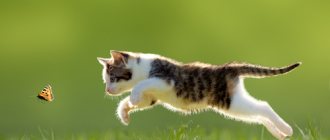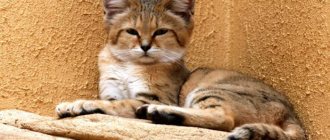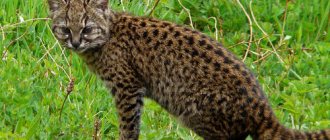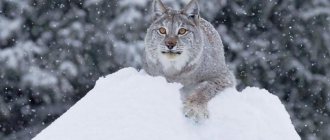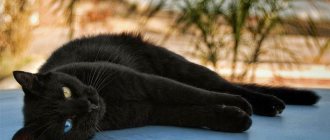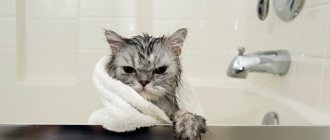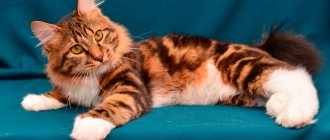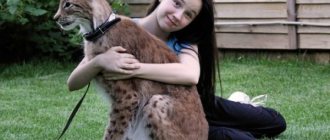Description
Cats of the Nibelung breed have a luxurious coat of soft long wool of a gray-blue color with silver tips.
From the outside, it seems that a light, smoky halo is reflected above this amazing pet. The appearance of this beautiful kitten is harmoniously complemented by large emerald eyes. At birth, a Nibelung kitten has yellow eyes, and only closer to 4-5 months does a green ring appear on the pupils. Gradually it transforms the eye color into an intense green.
Standard for Nibelung cats:
- slender body of medium size;
- small, sophisticated paws with oval pads;
- a small wedge-shaped head with an elongated but not powerful neck;
- large, widely spaced ears;
- straight nose with a necessarily gray nose;
- large round eyes;
- long and slightly pointed tail with a luxurious plume;
- The coat is silky, smoky blue, of unusual structure.
Nibelung cats can be tall, their body weight varies between 2-5 kg. Average life expectancy is 12-15 years.
Nibelung cats have a special character. Kind and sweet creatures are very loyal to their owner. They love all family members without exception, but become attached to one. They are ready to surround only a chosen person with love and affection; they can treat everyone else with respect, but without showing any special tenderness.
Thoroughbred representatives have a fairly positive character and decent demeanor. From the first days of a kitten’s stay in the house, it will not be possible to discern its true qualities, which is due to their conservative behavior.
In a new environment among unfamiliar people, the cat will behave modestly and inconspicuously until it adapts. Over time, he will get used to it and finally show his good-natured and cheerful character.
Little kittens love active games and the attention of household members; they will happily spend time in the company of children and toys, but then they will again rush to their chosen owner, climb into their arms and purr a cat song in their quiet and melodious voice.
Nibelungs get along well with other animals in the house and cannot stand being alone. An offended cat, left alone to the mercy of fate in a closed apartment, can play pranks and ruin the owner’s favorite things. If you got a kitten of this breed, but do not have the opportunity to spend a significant part of your time with this wonderful creature, get another pet to brighten up its loneliness.
Nibelung cats do not like strangers in the house and are wary of guests. When they see unfamiliar faces, they hide in a secluded place. And also, they really don’t like loud screams and scandals. In such situations, the Nibelungs also try to hide from visibility and wait it out. This behavior is justified by their excessive peacefulness.
Nibelungs are excellent cats with a good-natured character and slightly aristocratic manners. They feel comfortable both in a large house and in a small apartment.
Thoroughbred representatives are endowed with genetically good health. They have no predisposition to hereditary diseases. However, like cats of other breeds, Nibelungs should be vaccinated according to age to eliminate the risk of contracting various infections from other animals.
Caring for cats of this breed is standard:
- periodic washing of wool using special products for bathing animals;
- regular brushing of the fur with a wire brush;
- washing eyes;
- cleaning ears and teeth;
- trimming nails as they grow.
Experts do not recommend walking a Nibelung kitten in sunny weather. Ultraviolet rays have a negative effect on your pet's fur. As a result of such walks, a beautiful fur coat will lose its shine and an unsightly “rusty” tint will appear.
Proper care of a beautiful representative of the Nibelung breed also includes a balanced diet. It is better to feed your cat natural food made from high-quality products without spices and salt.
Gradually, you can switch your growing cat to eating ready-made industrial food. This is very convenient for busy people who do not have the opportunity to prepare healthy meals for their furry family member. True, experienced breeders still recommend feeding a Nibelung cat with natural food that is more suitable for its body.
The menu is made up of products acceptable for feeding purebred representatives. The kitten can be fed with vitamins A and B, which improve the quality of the coat.
Proper care and healthy nutrition are the key to a long and happy life for your furry friend of the delightful Nibelung breed!
READ Symptoms and treatment of epilepsy in cats at home
The Caucasian forest cat is listed in the Red Book of Russia. As a rare species, it is assigned number 3. Protected in the Caucasian, Teberdinsky and other reserves. No special measures have been developed to protect animals. This is a subspecies of wild cat that lives in the Caucasus and Turkey.
Large, of the usual “yard” color – this is approximately what the Caucasian forest cat looks like. Its description is presented below.
- Weight: males – 3.1-6.08 kg, females – 3.0-6.0 kg.
- Muscular body length: males - 50.1-67 cm, females - 52.3-61 cm.
- The length of the tail as a percentage of the length of the body is: in males - up to 60%, in females - up to 56%.
- The claws are large and sharp.
- The head is wide and rounded.
- The ears are round, up to 7 cm high.
- The mustache is long.
- The eyes are large, without eyelashes.
- The hairline is dense and luxuriant in winter.
Wild life has left its mark on the animal’s coat color:
- the general color is gray with a reddish streak, a black stripe runs along the ridge, there are dark stripes on the sides;
- black stripes are clearly visible on the head from the forehead to the back of the head;
- the bottom of the throat, belly, and groin areas are light, almost white, with an ocher tint, especially noticeable on the undertail;
- there may be vaguely outlined dark spots on the stomach;
- the tail is “decorated” with dark rings, the number is from 3 to 8.
This pattern allows animals to camouflage themselves for ambush hunting. It is brighter in summer and dims in winter. The cat prefers to hunt at night.
The mating season for cats begins in February-March. Pregnancy lasts 68-70 days. There are usually 3-5 kittens in a litter. They suckle their mother for up to 4 months. From the age of two months, the mother teaches them to get their own food. After six months, males leave their mother; girls can stay with her longer. Sexual maturity occurs at one year of age. The first offspring of young individuals appears by the age of three.
Forest cat name. Central European forest cat
The European forest cat is not a breed, much less a feral specimen of a domestic pet. This is exactly the type of cat from which, apparently, most of the natural breeds of cats known to mankind originated.
Wild European cats can be found in many zoos around the world. At first glance, these animals are no different from domestic cats. Moreover, in fact, these are dangerous and intelligent predators that are adapted to live only in natural conditions.
Scientists believe that the Forest Cat appeared in the Pleistocene era, which began more than 2.5 billion years ago and ended 11.7 million years ago. Considering that humanity is only 2.8 billion years old, wild cats are at least 9 years older than humans.
The end of the Pleistocene era is characterized by an incredibly harsh climate. The planet had just experienced an ice age, the ice masses were retreating reluctantly, weather conditions also changed in waves - periods of sharp warming alternated with periods of the onset of very cold air masses. These processes served as an impetus for the transformation of flora and fauna. It was at this time that the woolly rhinoceros, mammoth, giant deer, cave lion and many other species appeared, most fully adapted to harsh climatic conditions.
With subsequent global warming, most animals of the glacial and post-glacial periods were unable to mutate and became extinct. The cat, which went into the shady forests and mountain ranges, managed to survive.
Thus, we can only talk about the approximate, latest date of the emergence of the European forest cat as a species - 11.7 million years ago. Although, most likely, this animal is older and has survived to this day since the Ice Age without any special changes.
The domestication of cats occurred much later, about 10 thousand years ago, when people began to lead a sedentary lifestyle, build homes, develop agricultural land and stockpile food.
Mr. Cat recommends: characteristics
The Central European forest cat, Felis silvestris silvestris or European Wildcat, is a predatory mammal of the cat family. The Latin name for Forest Cats can be roughly translated as “a wild cat living in the forest.” They live on almost the entire planet, namely in Europe, Asia and Africa (steppe species are distinguished there). To understand the classification in more detail and understand it, read the article about. This article will focus only on those wild Forest cats that have acclimatized on European territory.
This is a small animal, which is still larger than an ordinary domestic cat, although it is very similar to it in its general structure:
- The body is quite long, elongated, muscular.
- Male individuals are from 45 to 93 cm in length, weigh 6-9 kg; females from 39 to 78 cm and 4-7 kg.
- The limbs are of medium length with sharp claws that can be hidden in the fingertips. They are well adapted for climbing trees and rocks, hunting and protecting themselves from enemies.
- The hind legs are somewhat longer and more powerful than the front legs. They help the animal make high jumps.
- The tail is of sufficient length (from 18 to 41 cm), usually slightly larger than the size of the body. Wide at the base and slightly tapering further, but its tip is not pointed, but rounded.
- Large head with developed wide cheekbones. The jaw is short and blunt. European forest cats have a larger cranial volume than domestic cats, a ratio known as the Schauenberg index.
- The ears are medium in size (5-7 cm), widely spaced, without tufts at the tips, but with inner feathering.
- The vibrissae are voluminous, thick, and white. Near the mouth there are 8-18 of them on each side, 5 to 8 cm long, near the eyes there are fewer of them - 7-8 and they are shorter (5-6 cm). But they are also on the inside of the hand, this is a group of 3-6 hairs 4-5 cm long.
- The eyes are large and widely spaced, with a slit-like vertical pupil. The iris is colored yellowish, greenish or emerald-golden.
- The lobe is flat, large, brick-colored.
- The coat is of uniform medium length throughout the body, it is much longer on the tail, making it appear large and fluffy.
- The undercoat is thick and voluminous. Because of it, the animal is perceived as much larger.
- Color in grayish tones. There are patterned lines on the head, back, sides, and tail. There are usually four clear lines on the back of the skull.
- The tail is surrounded by black rings, from three to ten.
- Summer fur after molting is much lighter, without ocher and brownish impurities, sometimes ashy.
- They usually have four pairs of nipples: two on the chest and two on the belly.
- The chromosome set includes 38 diploids.
History of the origin of the Nibelung
Nibelung cats have a very complicated origin story. The breed was officially recognized at the beginning of the 20th century.
According to modern breeders, kittens with long smoky hair appeared in the 19th century, but if you study some historical facts, according to which such representatives appeared at famous pet shows several centuries ago, we can conclude that Nibelung cats have a long history of existence .
The main difference between a Nibelung cat and a Russian Blue is the length of its coat. In previous centuries, long-haired bluish-silver kittens were born, which were simply classified as the Russian Blue breed.
Somewhat later, breeders from Europe and the USA became interested in the most beautiful representatives of the cat family. They began active work on breeding new offspring in compliance with certain standards. Today, the Nibelung breed is considered quite valuable and prestigious. In Russia, purebred representatives are rare.
Diet
The Caucasian forest cat is a medium-sized predator that is excellent at climbing trees and rocks. To hunt, the animal prefers to go down to the ground.
Most of its diet consists of rodents - mice, voles, dormice. I am ready to fight with such brave enemies as weasel, ermine, raccoon, rat, muskrat, nutria. Capable of catching a hare, snake, baby roe deer or deer.
Most of all he likes to hunt birds whose nests are located on the ground - pheasants, partridges, chukars, ducks.
Does not like to swim, but sometimes goes down to the water to catch fish, frogs or toads.
During the hungry season, it does not refuse lizards, insects, berries and herbs; it can enter human settlements and carry chickens, geese and turkeys, although it avoids people with all its might.
It does not move well in the snow, so it does not choose such areas for living and hunting.
The Caucasian cat eats a lot - an adult can eat up to twenty mice a day, and a teenager can eat about ten.
Care and education
The Caucasian forest cat is a predator. She freely climbs trees, but prefers to hunt on the ground. Its diet includes rodents of all kinds, lizards, fish, small birds, eggs and chicks. During a hunt, the animal can eat up to 20 mice. Hunting grounds per individual are up to 3 km2. In their habitats, they compete with raccoon dogs, badgers, striped raccoons, martens, and foxes.
The lack of the main object of hunting can force cats to hunt larger game. The diet includes pheasants, muskrat, nutria, hares and young ungulates. If possible, catch poultry. In addition, they eat small quantities of green cereals, fruits, insects and fresh carrion. Deep snow forces cats to migrate, it interferes with rapid movement and, accordingly, the extraction of food.
A small kitten in the house is the same as a child, requiring attention and love. To raise an obedient and intelligent cat, you will need to carry out educational work. First of all, the animal needs to be accustomed to a tray, where he can relieve himself if necessary. The owner should clean the cat litter box regularly.
You won’t be able to immediately force a cat to go to the toilet; you need to teach it to the litter box calmly, without showing anger or aggression, otherwise the offended cat will fundamentally not go to the indicated place. In addition, loud swearing from the owner can frighten a small pet, which will have a very negative impact on the character of the growing cat.
READ Interesting facts about why cats wash themselves so often
It is also important to designate a separate feeding area and place a small bowl there for water and food. Sleeping place is at the discretion of the owner. Some people happily let a furry animal into their bed, while others are against such a neighborhood. In any case, the issue of a place to rest at night for a new family member needs to be resolved from the first days of the cat’s appearance in the house.
From an early age, it is necessary to accustom the Norwegian Forest Cat to hygiene procedures, combing, brushing teeth and trimming growing claws. To carry out these activities, it is recommended to purchase special tools at a pet store.
Cats, by their nature, do not like water, so during bathing they can break out and scratch. However, if you accustom a Norwegian cat to the bath procedure from the first days of life in a new home, the animal will gradually get used to this procedure and will behave calmly while sitting in a basin of warm water.
The set of mandatory procedures for caring for a cat of this breed also includes careful cleaning of the ears and eyes from nitrous (cotton swabs and a special solution for cleaning the eyes are used).
Many people worry that having a rather fluffy Norwegian Forest cat in their home will cause a fur problem. In fact, caring for this pet’s luxurious coat is not as difficult as it seems at first glance. Minor difficulties arise only during the molting period.
The rest of the time, standard combing of the coat is carried out, 2-3 times a week. During the shedding period, this procedure is recommended to be carried out every day to reduce the spread of hair around the house.
The Norwegian Forest cat is not particularly picky in its diet and quickly gets used to the food it receives from the first days of life in its new home. However, the owner of a beautiful pet must remember that the health and appearance of his beloved cat depends on the quality of the diet.
What is important to consider when choosing products for cats of this breed:
- Food must be fresh and of high quality.
- You cannot feed a purebred pet with food from the human table.
- The diet must contain vitamin complexes that a fluffy cat needs for healthy development.
- When choosing dry food, you should give preference to premium products.
- You should not combine fermented milk products with meat, eggs or fish in one meal.
- The amount of calories received per day for an adult cat of this breed is 350-500 kcal.
- Norwegian forest cats are prone to obesity, so overfeeding the animal is unacceptable!
- There should always be clean water and fresh food in your pet's bowl.
- After feeding, it is necessary to wash the animal's dishes.
Recommended foods in the diet of a Norwegian cat:
- dietary meat, raw or boiled;
- offal;
- seafood, low-fat fish, always without bones;
- boiled eggs;
- fermented milk products with low fat content;
- boiled cereals;
- lightly dried bread;
- boiled vegetables and root vegetables.
To improve hair growth and the proper formation of a growing animal, it is necessary to introduce useful vitamins into complementary foods, on the recommendation of an experienced veterinarian. Vaccination is mandatory to reduce the risk of contracting unpleasant diseases and infections.
Also, the cat must be periodically given antihelminthic drugs purchased from specialized pharmacies for animals. Proper nutrition and proper care will allow you to raise a beautiful and healthy Norwegian cat with a kind character and amazing manners!
If you are captivated by the characteristics of a pet of this breed, we recommend choosing a Norwegian forest cat from professional breeders. It is better to buy a three-month-old kitten with purebred parents.
He should have a well-groomed coat, clean eyes and ears, even breathing and pink gums. If the abdominal cavity is hard when palpated, it means the kitten is infected with worms. Also pay attention to the baby's behavior. A purebred and healthy pet will be active, cheerful and restless. The average cost of a Norwegian Forest cat is from $150 to $500.
Appearance
External differences between a wild forest cat and its domestic counterpart are virtually invisible. The weight of a wild forest cat reaches 7 kg. But some species can reach quite large sizes - up to 15 kg. The body length reaches 90 cm. Actually, the size of the cat very much depends on its habitat and time of year. Any wild cat weighs much more in summer than in winter, since it gains fat over the summer.
The ears of a wild cat are set wide apart and mobile. The claws easily retract into the paws. The forest cat's vision is very good. The mouth is equipped with sharp fangs that are good at capturing and holding game. The molars are strong enough to chew caught prey.
Central European forest cats shed twice in spring and autumn, but in winter their fur is much thicker in order to protect the animal from severe frosts.
Habitat halo
The Caucasian wild cat can be found in the Caucasus and Turkey. They are common in the Krasnodar and Stavropol territories, Crimea, Dagestan, Chechnya, North Ossetia, Adygea region, Kabardino-Balkaria. They are also found in some regions of Georgia, Armenia and Azerbaijan. The total area of the territories where these predators live is about 1360 thousand hectares.
READ History of the Boxer Breed
A predator can be forced to leave its inhabited area by lack of food, human intervention, harsh winters with high rainfall, or the search for a mate. Animals rarely settle in abandoned buildings near human habitations and hunt poultry.
Animals are cautious and intelligent, so they can easily survive in their natural environment. The main diet consists of rodents, lizards and small birds. During one hunt they catch 10–20 pieces. In the absence of small prey, predators attack larger representatives of the fauna - nutria, muskrat, pheasant. Even young ungulates can become their victims.
Thanks to their color, predators practically blend into their environment, so ambush hunting is the most preferable and effective way of obtaining food. Sometimes cats give chase, easily catching up even with nimble hares. Animals are good swimmers and can easily cross a small body of water, but they do not enter the water unless necessary.
Up to 4 months, the basis of the kittens’ diet is mother’s milk. From 2 months, the mother begins to teach her cubs to hunt. From the age of 6 months, male kittens already lead an independent life in a new territory, females stay with their mother longer. Animals become capable of procreation by the age of 1 year, but have offspring only after reaching 3 years of age.
Animals prefer beech-fir broad-leaved forests and crooked forests. They are found in European and Asian countries. In Russia, they are common in Chechnya, the southern part of Dagestan, Kabardino-Balkaria, Adygea, North Ossetia, the Krasnodar and Stavropol territories. There are populations in Armenia, Azerbaijan, and Georgia.
Cats prefer remote areas of the forest, choosing rock crevices, old burrows of other animals, and even hollows. Near rivers they live in dense thickets of bushes and reeds. Animals have been spotted near human buildings; they may take a liking to abandoned buildings.
Despite the scant information about the animals, there is some information about how the Caucasian forest cat lives. Interesting facts about them can be found in the list below:
- they have no natural enemies in their habitats;
- in the North Caucasus they are not in danger of degeneration due to mating with domestic cats; harsh living conditions will not allow hybrids to survive;
- live at an altitude of 2500-3000 meters above sea level;
- They prefer to attack from ambush; they very rarely pursue fleeing game, but they can easily catch a hare.
Amur forest cat interesting facts. Amur cat: In the taiga, even seals kill roe deer
Greetings, ladies and gentlemen. Creepy horror is, of course, good. But today we decided to please you with a cute creature. No, this is not the neighbor's cat Barsik, as you might think. Our guest was a proud representative of the forest cats. This animal will not only catch a mouse, but also punch you in the face when the opportunity arises. Say hello to the Amur forest cat! A beast with an extremely charming pug and an unbridled temper.
What are leopards and tigers like? This is who they should be afraid of in the Far East!
Let's start with the classics, with appearance. The forest pussy is larger than its domestic counterparts. The length of its body from the tip of the nose to the tip of the tail is 75-90 cm. The weight of the sheep is approximately equal to a bucket of cucumbers - 4-6 kg.
A thick and long fur coat protects the animal from wild frosts.
In China, our heroine is called “money cat” for the spots that decorate her fur. How the Asians saw the coins in the blurry patterns, I don’t know. But, in fairness, we note that the spots really bring material wealth to the animal. Camouflage helps to blend into the forest landscape, which significantly increases the hunter's chance of killing someone for dinner.
Darling, am I really your first?
This thing lives in the Far East, in the Amur River basin and along the coast of the Sea of Japan. Our hero has to share his shelter with larger and more popular brothers: the Far Eastern leopard and the Amur tiger. But don't underestimate this cutie. Local hunters talked about cases of the furry asshole attacking a person. He didn’t kill, but he fought and bit a lot!
It's a pleasure to die from such a cutie.
The cat eats a very standard diet: mice, voles, squirrels, birds. But as the famous advertisement says: “You are not you when you are hungry.” During the feast, the beast turns into a real killing machine. Unlike your four-legged lazy fellow, this wild hunter is capable of killing a whole roe deer! I don’t think it’s worth explaining the proportional difference between a cat and an artiodactyl, right? At the same time, the hunt ends successfully in 90% of cases. This is, his mother, a little berserker of the Amur taiga.
Valhalla is waiting for me
Furry messengers of death reach sexual maturity at the age of 1 year. The shepherds start screaming like crazy at the same time as your unsterilized Murka - in March. After a sneeze-puff, the female walks around with a little pot-bellied body for 65-70 days. On average, a cat gives birth to 2-4 kittens.
Amur cats are very good mothers. The female constantly moves her den to ensure safety for her offspring.
Unlike other cats, after satisfying his base needs, the male does not abandon the expectant mother, but remains with her. Moreover, he helps the female take care of their common babies: he brings food to the den and protects the kittens. The family idyll will not last long - only six months. At 6 months, babies go into adulthood to experience the delights and dangers of the Amur taiga on their own.
Amur cats live 15-18 years.
The cute fluffy animal is listed in the Red Book. Man not only cut down the forests where our spotted friend lives, but also purposefully shot the cat. And all because a skilled hunter easily plundered the farm. Rabbits, chickens, ducks, geese and even piglets fell victims to this forest dweller. In general, you can’t expect anything else from the Amur Berserker.
The embodiment of the harsh spirit of the taiga.
The Book of Animals was with you.
Thumbs up, subscription - support for the author’s work.
How much does it cost and where to buy in Russia?
The Nibelung is a very rare cat breed in Russia. You can buy a purebred representative with the most beautiful coat of the original color only in the St. Petersburg nursery “Severnaya Zvezda”. There are photos of pets on the official website. The price for such kittens is quite high. The minimum cost of a Nibelung kitten is 50,000 rubles (price in Russia).
Many lovers of this valuable breed purchase a purebred Nibelung kitten in foreign nurseries, but it should immediately be noted that such a purchase will have to spend a decent amount.
How much does a Nibelung cat cost in nurseries in Europe and the USA? Prices start from $1,000. To this you need to add the costs of flights, paperwork for the animal’s flight and other necessary expenses. Based on this, we can conclude that a Nibelung kitten is an expensive pleasure that is not affordable for everyone.
If you dream of getting a beautiful kitten with silver-blue fur and an affectionate character, but do not have the available budget to buy a real Nibelung, pay attention to their close relatives - Russian Blue cats, which are more affordable. The cost of such a pretty representative varies between 2-20 thousand rubles.
Notes
- Aristov A. A., Baryshnikov G. F.
Mammals of the fauna of Russia and adjacent territories. Predatory and pinnipeds (In the series: Guides to the fauna of Russia, published by the Zoological Institute of the Russian Academy of Sciences. Issue 169). - St. Petersburg, 2001. - P. 408. - 560 p. - Caucasian forest cat // Red Book of the Russian Federation. Volume 1. Animals. - M.: AST, 2001. - P. 643-645. — 862 p. — ISBN 5-17-004878-5 [biodat.ru/db/rb/rb.php?src=1&vid=388]
- Animal world.
[www.zooeco.com/eco-mlek/eco-mlek407q10.html Wild (European, forest) cat] (Russian). - [www.ecocommunity.ru/rb.php?id=26&subj=1&page=3 Caucasian Forest Cat (Felis Silvestris)]. [www.webcitation.org/68tRvaSzU Archived from the original on July 4, 2012].
| This is a draft article on zoology. You can help the project by adding to it. |
